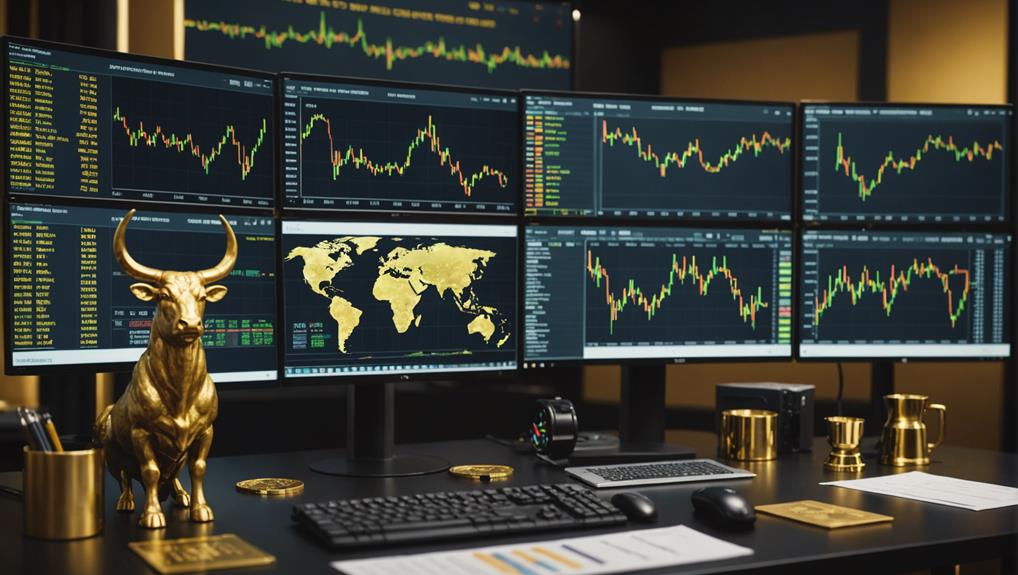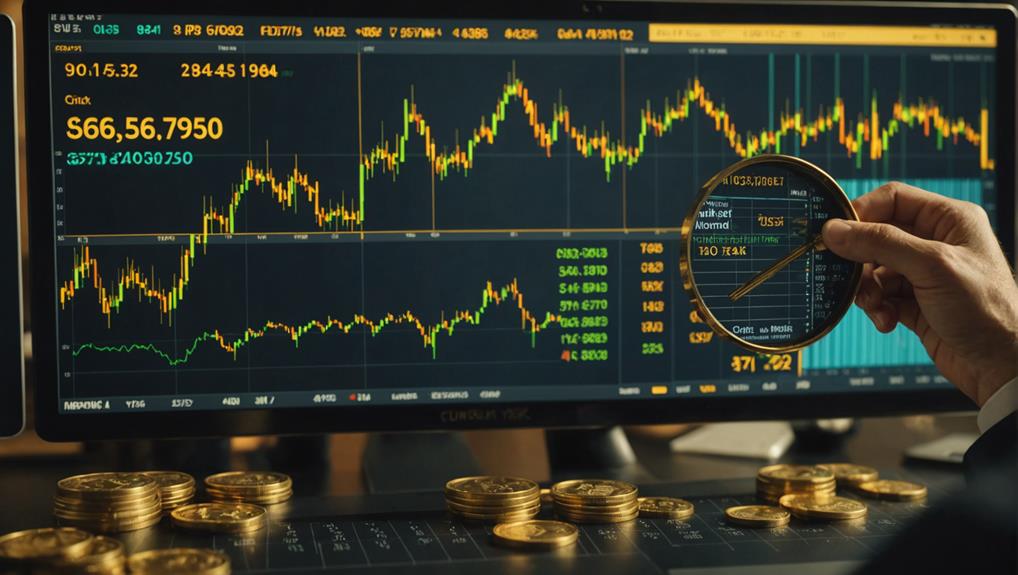To navigate the complexities of gold futures markets successfully, a strategic approach is essential, balancing risk management and timely decision-making.
Incorporating stop-loss orders is crucial, as they help mitigate potential losses and safeguard investments.
Diversifying your portfolio across various asset classes is equally important to spread risk effectively.
Keeping abreast of economic indicators and market trends will further enhance your ability to make well-informed investment choices.
Additionally, utilizing options strategies to hedge against adverse price movements and aligning trades with optimal trading hours can significantly enhance profitability.
There is always more to explore and learn about thriving in this dynamic investment landscape.
Key Insights
- Diversify your portfolio to mitigate risk and enhance stability.
- Use stop-loss orders to limit potential losses and manage risk effectively.
- Trade during peak liquidity hours for optimal price movements and profitability.
- Employ leveraged positions cautiously to amplify gains while being mindful of potential losses.
- Stay informed about economic indicators and geopolitical events affecting gold prices.
Understanding Gold Futures Contracts

Gold futures contracts are financial tools that allow investors to buy or sell a specified amount of gold at a predetermined price on a future date. These contracts provide a way for investors to participate in the gold market without needing to physically possess the metal, offering benefits such as leverage and liquidity.
By meeting margin requirements, investors can control large positions with a smaller initial investment. Gold futures are commonly used for hedging purposes, enabling market participants such as miners and manufacturers to manage price risk and secure future supply at agreed-upon prices. Additionally, these contracts attract speculators seeking to capitalize on price fluctuations.
Standardized terms related to quantity, quality, delivery, and expiration dates make gold futures contracts easily tradable on exchanges, ensuring transparency and efficiency in trading.
Benefits of Investing in Gold Futures
Investing in gold futures offers several advantages, including the ability to hedge against inflation and other market risks.
These contracts provide leveraged investment opportunities, allowing investors to control a larger position with a relatively smaller amount of capital.
Gold futures offer a high level of liquidity and price transparency, making them an attractive option for both hedging and speculative strategies.
Hedging Against Inflation
Gold futures are a reliable strategy for investors seeking protection against inflation. These futures can effectively safeguard portfolios from the eroding effects of rising prices by maintaining purchasing power over time. The historical inverse correlation between gold and inflation further solidifies its reputation as a popular choice for hedging purposes.
By investing in gold futures, investors can secure current prices, mitigating potential losses stemming from future inflation. This proactive approach shields portfolios from inflation's negative consequences while also positioning investors to capitalize on potential price increases resulting from inflationary pressures.
In essence, gold futures serve as a valuable asset for ensuring the stability of long-term investment portfolios.
Leveraged Investment Opportunities
Gold futures offer traders the opportunity to control substantial contract values with minimal initial investments, thanks to leverage. This feature can amplify both potential gains and losses, enhancing profit opportunities.
By trading gold futures, investors can capitalize on price movements without the need to physically own the commodity.
The key benefits of leveraging investment in gold futures include:
- Enhanced Profit Potential: Leverage allows even small price fluctuations to lead to significant returns.
- Speculative Flexibility: Traders can speculate on the direction of gold prices, enabling a versatile trading approach.
- Market Liquidity and Transparency: Gold futures markets are highly liquid and provide transparent pricing, facilitating efficient entry and exit from positions.
These advantages make gold futures an appealing choice for investors seeking amplified investment opportunities.
Risks and Drawbacks

When investing in gold futures markets, traders must be aware of the significant risks and drawbacks associated with high leverage and market volatility. Leverage can magnify both potential gains and losses, making precise market timing essential to avoid substantial financial setbacks.
The intrinsic volatility of gold prices, influenced by economic events and geopolitical factors, can lead to rapid and unpredictable market movements.
Leverage and Losses
Trading gold futures with leverage can amplify potential profits and losses, emphasizing the need for traders to fully grasp the associated risks. Leverage offers the ability to control substantial positions with a modest amount of capital, but this exposure can result in significant losses, especially in volatile markets.
Margin calls play a pivotal role in leveraged trading, necessitating traders to inject additional funds if their positions move against them. Effective risk management strategies are essential to navigate these challenges successfully.
Key considerations for traders include:
- Understanding Margin Requirements: It is crucial to be well-informed about the capital needed to sustain your trading positions.
- Implementing Stop-Loss Orders: Safeguard your investment by setting automatic closure points for positions at predetermined loss thresholds.
- Monitoring Positions Regularly: Stay vigilant and responsive to market fluctuations to make informed decisions promptly.
Market Volatility Impact
Navigating leverage in gold futures trading is vital, yet traders must also consider the impact of market volatility, which can significantly influence trading outcomes. The unpredictable nature of market volatility can result in rapid price fluctuations, potentially jeopardizing traders' positions and profits. Factors such as geopolitical events, economic data releases, and shifts in investor sentiment can exacerbate this volatility, leading to wider bid-ask spreads and heightened trading costs. To effectively manage these challenges, traders must prioritize robust risk management strategies and employ tactical trading approaches. Remaining vigilant against sudden price swings that could trigger margin calls and escalate risk exposure is imperative.
| Factor | Impact on Volatility | Risk Management Approach |
|---|---|---|
| Geopolitical Events | Increased Price Fluctuations | Stay Informed, Adjust Positions |
| Economic Data Releases | Swift Market Movements | Utilize Stop-Loss Orders |
| Investor Sentiment | Broader Bid-Ask Spreads | Implement Diversified Trading Strategies |
Developing a Trading Strategy
To develop a robust gold futures trading strategy, it is essential to carefully assess your risk tolerance, investment objectives, and the current market landscape. This involves utilizing key components such as technical analysis, fundamental analysis, and risk management.
Technical analysis plays a crucial role in predicting price movements by utilizing chart patterns and indicators. On the other hand, fundamental analysis involves evaluating economic indicators and geopolitical events that can influence gold prices. Together, these analyses provide a comprehensive understanding of the market dynamics.
Effective risk management is another critical aspect of a successful trading strategy. Implementing stop-loss orders and employing proper position sizing are essential to protect your investments. Monitoring market sentiment and trends regularly allows for adjustments to the strategy based on performance and changing market conditions.
Choosing the Right Contract

Choosing the right gold futures contract is essential for meeting your investment goals and risk tolerance. To make the best selection, consider factors such as contract size, which typically ranges from 32.15 to 100 troy ounces, and tick size, set at 10 cents per contract for minimum price movement.
Familiarize yourself with the primary trading months of February, April, June, August, October, and December, as well as the trading hours from 6 p.m. EST to 5 p.m. EST Sunday through Friday.
It is crucial to partner with a reputable brokerage that provides access to trading gold futures on major exchanges like COMEX and ICE to ensure reliable execution and support.
Timing Your Investments
Timing your gold futures investments is just as crucial as selecting the right contract. Gold futures are actively traded from 6 p.m. EST to 5 p.m. EST Sunday through Friday, providing numerous trading opportunities. However, the most active price fluctuations typically occur between 6 a.m. EST and 10 a.m. EST, coinciding with major market overlaps.
By strategically timing your investments during these peak trading hours, you can enhance your investment strategies and take advantage of market movements. Here are three key factors to consider:
- Peak Trading Hours: The highest liquidity is observed when the US and European markets overlap.
- Market Movements: Significant price changes tend to occur during the early trading hours.
- Investment Decisions: Aligning your trades with these critical periods can potentially increase your profitability.
Portfolio Diversification

Integrating gold futures into your investment portfolio can effectively reduce risk and enhance stability by diversifying across asset classes. This diversification shields investors from market volatility and economic uncertainty.
Gold futures, being highly liquid and easily tradable, are an attractive option for hedging against inflation and currency fluctuations. Including gold futures in your portfolio can lower overall risk exposure and potentially enhance long-term returns.
This strategy helps safeguard against unpredictable economic shifts, contributing to a more robust and resilient investment portfolio that performs steadily across different market conditions. Gold futures not only serve as a hedge but also play a vital role in fortifying your portfolio.
Managing Risk
To effectively safeguard investments and ensure long-term profitability in gold futures trading, a robust risk management strategy is essential. This strategy should encompass key elements such as the use of stop-loss orders to limit potential losses by automatically selling a position at a predetermined price.
Additionally, diversifying the portfolio across various asset classes can help reduce exposure to volatility in any single market. Options strategies can also be employed to hedge against adverse price movements in the gold futures market.
Remaining well-informed about economic indicators and market trends is crucial for making informed decisions. It is important to regularly review and adjust the risk management strategy in response to changing market conditions to maintain adaptability and resilience in the dynamic gold futures market.
Conclusion
To achieve success in gold futures markets, a robust risk management strategy is essential. This includes implementing stop-loss orders and diversifying your portfolio effectively.
Stay updated on economic indicators and market trends to make informed investment decisions. Consider using options strategies to hedge against potential price fluctuations and align your trades with peak trading hours for increased profitability.
By mastering these key components, investors can navigate the complexities of gold futures markets with greater efficiency.
The Gold Information Network
11900 Biscayne Blvd, Ste 127B, Miami, FL 33181
(305) 449-9094
https://goldinfo.net







